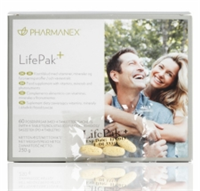The Building Blocks for Proper Nutrition
July 30, 2014

This year we celebrate our 30th anniversary at Nu Skin. We have seen many scientific discoveries in nutrition over the past 30 years, and this time for Nu Skin has been filled with innovative milestones as well. This includes, but is not limited to, the development of our cornerstone nutrition product, LifePak.
LifePak startedwith a base of well-researched micronutrients, in the best-understood bioavailable forms at the right balanced levels. We then incorporated the (then) relatively new science of antioxidant research by including antioxidants in levels shown to make a difference. Finally, we included phytochemicals – plant bioactive nutrients that had been shown to provide benefits beyond basic nutritive value. This was another new concept in 1993 and is still an area of active research.
Over the past 20 years, LifePak has evolved several times, including now being labelled as LifePak Nano, in order to keep up with both the new understandings in nutrition science as well as the improvements in vitamin, mineral and phytonutrient forms that add more meaningful potency and shelf-life stability.
Look at the back of the Lifepak Nano box and you will see that the ingredients are divided up into meaningful sections. There are 13 vitamins in the vitamin list and 10 minerals in the mineral list. Next you’ll see the sub headings, namely: Marine Lipid Concentrate, Polyphenol and Flavonoid Blend, Tocopherol blend, Carotenoid Blend, and various other ingredients.
In this short article we don’t have space to discuss all of the ingredients in LifePak, but let’s talk about a just two of the subheadings; the Mixed Tocopherols and the Polyphenol and Flavonoid Blend.
First, the Mixed Tocopherols. Tocopherol is the scientific name for vitamin E. When vitamin E was first discovered in 1922, scientists mistakenly concluded that vitamin E was a single compound – d-alpha tocopherol. To this day, most Vitamin E supplements in the U.S. still contain only d-alpha tocopherol.
Only over the past 2 decades have scientists discovered the important health benefits of the long-ignored members of the E vitamin group: d-gamma, d-delta and d-beta tocopherol, which have differing, but beneficial and complementary benefits. So while d-alpha tocopherol alone does provide certain benefits, the latest science informs us that the complete benefits of vitamin E supplements come when all four (alpha-, beta-, gamma-, delta-) tocopherol members of the vitamin E family are included.
Next, look at the Polyphenol and Flavonoid section and the Carotenoid section. You will see an interesting array of names like “catechins” from tea leaf extract, “citrus bioflavonoids” from citrus fruits, “quercetin”, “resveratrol” and others. How did these ingredients end up in Lifepak? What guided their presence and their levels in this supplement?
Quite simply, the scientists at Pharmanex used nature as our best guide.
Humans have evolved side by side with edible plants, and the availability of the chemicals from these plants has even allowed our bodies to forego having to manufacture some them, like vitamin C. But our bodies also seem to be able to take advantage of these plant chemicals in other ways. Our eyes use some of the carotenoids to help protect them from harmful visible light radiation, and recent scientific discoveries have shown that some of these phytochemicals, especially the flavonoids, are able to influence the expression of our genes.
Even though these plant chemicals are not listed on the World Health Organization (WHO) list of essential vitamins and minerals, they seem to play a very important role in influencing fundamental aspects of our cellular machinery. These nutrients are the dietary constituents of healthy, plant-based eating habits, and at Pharmanex we’ve assembled them in the levels and proportions that one would find in such healthy diets.
It’s amazing what the body can do when provided the building blocks necessary for proper health and nutrition. Many of these building blocks come from nature and are included in easy-to-consume supplements for our benefit. Nutritional science has progressed significantly in the past 30 years, and we can only imagine the things we will have learned from nature by the time our 60th anniversary comes around.

Posted by Mark Bartlett, Ph.D.
You Might Also Like:
-
Most people today live busier lives than ever before. And much of that time is spent sitting at a computer or behind a desk. Despite the attention on being physically fit, a recent survey from the Centers for Disease Control and Prevention (CDC) says almost half of American adults don’t get enough exercise. Luckily, there are a number of relatively easy workouts you can do to break up periods of i...
-
Being a professional soccer player isn’t easy. Core strength, endurance, balance and agility are all required to stand out in the game that has the average player running up to 9.5 miles per 90 minute match. Just because you aren’t a World Cup soccer player, doesn’t mean you can’t train like one – whether it’s to improve your soccer game or simply get in shape.

